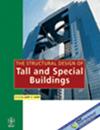开腹板钢梁整体与局部静力性能比较研究
IF 1.3
3区 工程技术
Q3 CONSTRUCTION & BUILDING TECHNOLOGY
引用次数: 1
摘要
为了量化已在实际工程中测试或应用的五种类型的钢开腹板梁的力学性能,基于相同的尺寸和材料条件,对钢开腹板的整体和局部力学性能进行了系统研究。对8×8网格空腹梁的剪切变形准交叉梁法进行了全面研究,以导出荷载分布系数的决定因素。基于荷载分布因子,从理论上推导了任意剪切关键节点域(SKND)的本质和公式。通过对H型单向SKND的测试验证了数值模型的可靠性,从而对单向和双向SKND进行了荷载-位移的比较研究。获得了H型、TH型、TS型、T型和DT型空腹梁的整体抗弯承载力和SKND承载力的定量结果。五根空腹梁弹性阶段的最大剪切变形占整体变形的39.04%-54.76%。在本研究中,基于当前等效密肋实体梁(DRSB)的实际设计,对建模分析的调整因子进行了修正。首次提出了SKND在双向力作用下的设计承载力方法。本文章由计算机程序翻译,如有差异,请以英文原文为准。
Comparative study on overall and local static performance of steel open‐web girders
To quantify the mechanical properties of five types of steel open‐web girders that have been tested or applied in practical engineering, a systematic study of the overall and local mechanical properties of steel open‐web girders based on the same dimensions and material conditions was presented. An overall study of the quasi‐intersection beam method for shear deformation was introduced for 8 × 8 grid open‐web girders to derive the determinants of the load distribution factor. Based on the load distribution factors, the essence and formula of any shear key node domain (SKND) were derived theoretically. The reliability of the numerical model was verified by tests on the H‐type unidirectional SKNDs, which led to a comparative load–displacement study of unidirectional and bidirectional SKNDs. Quantitative results of the overall flexural capacity and SKND load capacity of the H‐type, TH‐type, TS‐type, T‐type, and DT‐type open‐web girders were obtained. The maximum shear deformation in the elastic phase of the five open‐web girders accounted for 39.04% to 54.76% of the overall deformation. In this study, the adjustment factors of the modeling analysis based on the current practical design of equivalent dense‐ribbed solid beams (DRSBs) were revised. A method of SKND's design load capacity under the action of bidirectional forces was put forward for the first time.
求助全文
通过发布文献求助,成功后即可免费获取论文全文。
去求助
来源期刊
CiteScore
5.30
自引率
4.20%
发文量
83
审稿时长
6-12 weeks
期刊介绍:
The Structural Design of Tall and Special Buildings provides structural engineers and contractors with a detailed written presentation of innovative structural engineering and construction practices for tall and special buildings. It also presents applied research on new materials or analysis methods that can directly benefit structural engineers involved in the design of tall and special buildings. The editor''s policy is to maintain a reasonable balance between papers from design engineers and from research workers so that the Journal will be useful to both groups. The problems in this field and their solutions are international in character and require a knowledge of several traditional disciplines and the Journal will reflect this.
The main subject of the Journal is the structural design and construction of tall and special buildings. The basic definition of a tall building, in the context of the Journal audience, is a structure that is equal to or greater than 50 meters (165 feet) in height, or 14 stories or greater. A special building is one with unique architectural or structural characteristics.
However, manuscripts dealing with chimneys, water towers, silos, cooling towers, and pools will generally not be considered for review. The journal will present papers on new innovative structural systems, materials and methods of analysis.

 求助内容:
求助内容: 应助结果提醒方式:
应助结果提醒方式:


